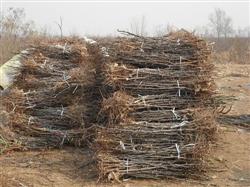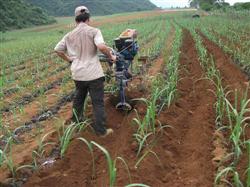Sugarcane planting technology: what is sugarcane smut?

What is sugarcane smut? What caused it? How to prevent and cure sugarcane smut? Please give an introduction to the planting network to sort out the harm and control methods of sugarcane smut, which are listed below for netizens' reference. The harm of sugarcane smut: sugarcane smut, also known as sugarcane smut, smut, ash bag disease or male sugarcane, is a fungal disease, which mainly harms the tillering stage. After the disease, the sugarcane plant grows a black whip from the tip, and then the leaves and internodes become thinner, which can not form an effective sugarcane and reduce the yield and quality. After the onset of sugarcane smut, there is a black whip on the top of the diseased sugarcane, called black whip, which ranges from a few centimeters to a few centimeters. The center of the whip is a cardiac column composed of parenchyma or vascular bundle tissue, surrounded by a thick layer of chlamydospores. At the initial stage of its formation, the disease whip is covered with a silver film, that is, the sugarcane epidermis. Before the whip was extracted from the diseased plant, the leaf was slender, the leaf color was light green, the stem was small, the Internode was long, and then broke and scattered a large amount of black powder, and finally only the heart column was left. The infected sugarcane sprouted early, the stem was small, the leaf was slender, light green, the tiller increased, and the black ear whip also grew on the back tiller. Sugarcane smut is mainly transmitted by chlamydospores. Chlamydospores can survive in dry soil for several months to 1 year. Drought in winter and spring is beneficial to the survival of winter spores, while high temperature and humidity is beneficial to the germination and invasion of the pathogen. Therefore, in the irrigated areas with long-term drought and high temperature, and the areas with drought in winter and spring and rain in summer and autumn, the incidence of sugarcane whip smut is high and serious. The disease of persistent root sugarcane field is more serious than that of newly planted sugarcane field; the longer the age of persistent root is, the more serious the disease is; the disease of tip seedling is lighter than that of whole plant; too much nitrogen fertilizer will promote late tillering and lateral bud growth, and the disease is more serious. Sugarcane smut control methods: new planting sugarcane control 1, replacement of improved varieties, breeding of disease-resistant varieties. For example, Yuetang 57Universe 423, Yuetang 63Compare 237, Xintai 16, NTSC 25 and so on. 2. Strict disinfection of seedlings should be carried out when planting. Soak the seeds in 52 ℃ hot water for 18 minutes for 30 minutes, and add 25% triadimefon wettable powder or 80% spray gram wettable powder 500x solution for better effect. The seeds can also be soaked in 43% formalin solution of 1VR 100 for 5 minutes, and then covered with film for 2 hours. Or 70% mancozeb wettable powder 1RU 500 times soak the seeds for 5 minutes. The seeds can also be soaked in 3% lime water for 24 hours. 3. Leave the top seedlings as seedlings (one meter below the growth point, the part covered by sugarcane leaves). Generally, when planting sugarcane in autumn, the seedling bud can be used as a whole seedling, and when planting sugarcane seedling bud in spring, the top seedling must be selected as the seedling. 4. Carry out detoxification treatment and establish a breeding base for improved varieties. 5. Crop rotation should be carried out conditionally. It is better to rotate rice, corn, sweet potato, peanut and other crops. Control of ratoon sugarcane (1) those with persistent roots should be cut low, it is best to leave low buds growing from the soil, and high buds are strictly prohibited to reduce the infection of smut pathogen. (2) after the last crop of sugarcane was harvested, the leaves of sugarcane were burned in time to reduce the parasitism and spread of spores. (3) find the diseased plant, eradicate it in time, and burn it centrally. It is best to pull out the diseased plant before pulling out the black ear. Those who take out the black whip should carefully cut it down and put it in a plastic bag, take it out of the field and burn it. The diseased field does not leave a permanent root, and the stubble of the diseased plant will be burned. (4) timely ploughing management, early loosening, early release of water, early topdressing, early weeding and early soil cultivation, so as to make its growth strong and enhance the disease resistance of the plant itself. Click for more sugarcane planting techniques click to get more fruit planting techniques
- Prev

What should we pay attention to when planting jujube in autumn?
What should we pay attention to when planting jujube in autumn? Please guide the planting of jujube trees in autumn to pay attention to the following points for reference: key points for attention: avoid damage to the root system as far as possible. In order to facilitate planting, the main root can be slightly trimmed after seedling, so as to facilitate the seedling to absorb water and improve the survival rate. When the seedlings are transported, they should be transported.
- Next

Sugarcane planting technology: why should sugarcane cultivate soil?
Why should sugarcane be cultivated? What are the benefits of sugarcane cultivation? How to cultivate sugarcane? Please introduce the benefits and methods of cultivating sugarcane through the planting network one by one, which are listed below for netizens' reference. Sugarcane cultivates soil because sugarcane borer (heart borer) not only harms sugarcane seedlings and leads to withered seedlings, but also.
Related
- Moge, come on! The staff of the peasant association in the producing area of cantaloupe were frightened when the crowd gathered.
- Causes and Solutions of low Fruit setting rate of Apple
- Symptoms and control measures of passion fruit virus disease
- Fruit growing lesson: how do apple orchards keep high yields?
- Can you build orchards in the mountains? What are the pros and cons?
- How to manage the coloring period of Crisson grape?
- This paper introduces the processing technology of two kinds of fig products.
- How much is a month for retired teachers in rural areas by 2020?
- How can strawberry planting increase sugar content? We should pay attention to management in many aspects.
- What are the cultivation techniques on how to improve the yield of golden fruit?

